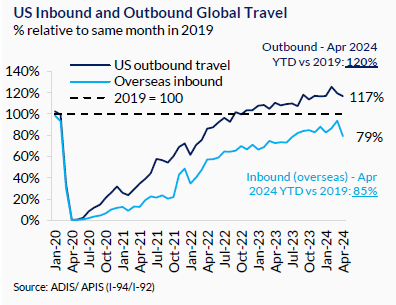By Joshua Friedlander
This summer, millions of Americans will travel to Europe, many to visit historical cities and one-of-a-kind beaches like Sitges, Biarritz, Tropea and Mykonos. But in Europe this year there is another one-of-a-kind attraction drawing travelers from the States in record numbers—the European leg of Taylor Swift’s “Eras” tour.
Taylor’s record-setting concerts across the U.S. in 2023 made fans and economists alike rethink the impact an artist can have on a city or region. With ticket prices regularly reaching 4-digit levels, and fans traveling distances reminiscent of festivals like Coachella, the economic impact of her tour was unprecedented.
Just as Grateful Dead fans were known to follow the band from city to city to be part of a unique community, Swifties—often with friends and family in tow—have made traveling to her concerts part of the experience. Between the lure of cheaper tickets in other cities and the chance to indulge in COVID-delayed vacations, a significant share of the 4.3 million attendees at her 60 shows in the U.S. traveled outside their home cities for the experience.
All indications point to that trend continuing this summer in Europe. But those travelers are definitely not limited to her fans on the continent. Recent reports estimate that nearly a quarter of tickets sold to a recent show in Paris were to Americans. The appeal is there, and the urge to travel this summer remains strong. A new survey from Longwoods International shows that U.S. travelers are shaking off financial concerns with 39% reporting they plan a trip overseas within the next year.
With hefty spending sure to continue at each of her tour stops, her effect on the economy in Europe is expected to be massive. In numbers, if trends from the first part of the tour continue, her 51 scheduled dates in Europe could very well result in more ticket sales than the up to 3.1 million expected for the Paris Olympics this July. And according to a new analysis from Barclays, before Taylor Swift says “So Long, London” with 5 (!) concerts at Wembley Stadium, she’ll have added more than $1.2 billion to the UK’s economy.
What does that all mean for the U.S. economy and travel? When overseas visitors come to the U.S., whatever they spend on their visit counts as net exports for the United States, helping with the balance of trade. Although travel remains one of the biggest service exports of the United States, as outbound travel has rebounded faster than inbound the net balance has turned to an estimated $47 billion net import based on analysis of BEA and NTTO data by Tourism Economics. That means all those Americans traveling to see Taylor Swift overseas are also effectively increasing imports, and negatively affecting the balance of trade.
If this wasn’t complicated enough, that spend in other countries by Americans is not all lost to the U.S. economy. As an American performer, Ms. Swift (and much of her crew, management and staff) will keep a sizeable portion of that revenue, effectively reclaiming it back as part of the U.S. GDP.
As great as Taylor Swift’s economic footprint—and that of her fans—a better bet for bolstering the economy is making sure that the U.S. is ready and able to host international visitors. Even after this tour is complete, we have more than enough incentives for international visitors in the not-too-distant future. The U.S. will be a host of the World Cup in 2026, the same year as the semi-quincentennial celebration of the Declaration of Independence (just imagine if the U.S. makes the round of 16 and plays in Philadelphia on July 4th!). Then Los Angeles will host the Olympics and Paralympics in 2028, and continuing the sports theme the U.S. will host the 2031 Rugby World Cup, which saw 2.4 million attendees in previous iterations. This stretch could very well define an Era.


